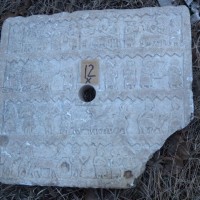
Late Bronze Age Jewelry Hoard from 3,000 Years Ago Discovered in Scottish Highlands

Pre excavation photo of the Late Bronze Age hoard prior to excavation in GUARD Archaeology’s Finds Lab. Photo by GUARD
UK researchers in Scotland have discovered a Late Bronze Age treasure trove filled with jewelry, believed to have been hidden around 3,000 years ago.
This treasure trove was found in Rosemarkie, a village in the Scottish Highlands, during archaeological digs preceding the construction of new housing developments, as reported by GUARD Archaeology, cited by Newsweek.
The excavation site was formerly a Bronze Age settlement, featuring at least six roundhouses and a stone tomb.
During the dig, the cache was meticulously extracted in its entirety and transported to GUARD’s Finds Lab in Glasgow for further examination, according to Ronan Toolis, CEO of the archaeological firm.
In-depth lab analysis by GUARD has recently illuminated the contents of the find, revealing nine bronze items: a complete neck ring, a fragmentary neck ring, six semi-circular bracelets, and a bracelet with cup-shaped ends.
Additionally, experts noticed fibrous plant cords wrapped around some bronze pieces.
“Most of the bronze artifacts and some of the plant remains were visible prior to our lab work. But the twisted cords used to tie some of the artifacts together only became apparent during our lab excavation,” Toolis explained.
While the analysis of the plant remnants is still ongoing, the metal items are tentatively dated to the Late Bronze Age, around 1000 B.C., pending further analysis and radiocarbon dating of the associated organic material, the researcher added.
“What makes the hoard especially significant is that it was not an isolated find with little context to explain it but was discovered within the middle of a prehistoric settlement. Altogether, GUARD Archaeology’s analysis of these archaeological remains will shed light upon the lives, beliefs and deaths of Bronze Age highlanders,” he remarked.
“While there are other examples of hoards where it has been postulated that items were bound together due to their positioning, the plant cords in the Rosemarkie hoard prove that these artifacts were held together,” Toolis further noted.
The preservation of the organic materials is partially attributed to the antimicrobial properties of copper found in bronze.
“The recovery of the artefacts was successfully carried out under the controlled conditions necessary to preserve these highly significant objects, particularly the very delicate organic cords that tether some of the objects together,” Rachel Buckley, who oversaw the laboratory excavation, highlighted in a GUARD press release.
In the forthcoming months, specialists will analyze the archaeological evidence further to hypothesize why the treasure was buried in Rosemarkie.
“That the hoard was buried under a single homogenous fill within a shallow pit with little extra room for anything other than what was found within indicates that this was no accidental loss,” Iraia Arabaolaza, who leads GUARD Archaeology’s analyses, suggested.
“It would seem that the shallow pit was dug to the required length and depth to accommodate the items before then being quickly backfilled,” Arabaolaza continued.
“It may be that it was intended as temporary storage with the intention of recovering the hoard at some stage. The evidence from the surrounding settlement may reveal whether it was not just the hoard that was abandoned but the settlement as well,” the researcher concluded.
***
Did you know that there is now an entire ancient nation made up of archaeologists?
It exists against all odds in “The Mudbrick Swamp,” a fantasy book by Ivan Dikov!
BUY ‘THE MUDBRICK SWAMP,’ Book 1, Volume 1, of the RODINIYA’S REASON fantasy series HERE!












